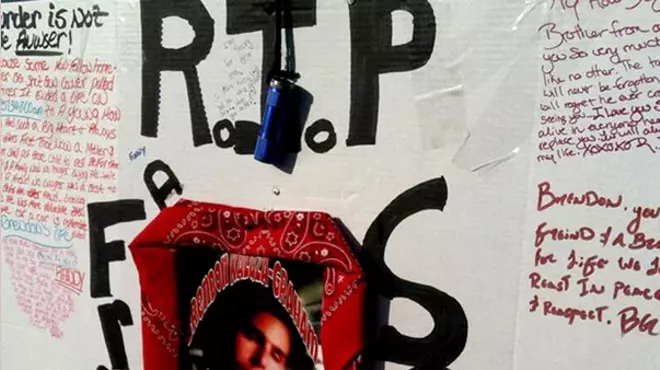Few people oppose the right to self-preservation. Even the Florida attorney representing the family of slain Trayvon Martin in the nation’s most controversial self-defense case acknowledges an individual’s legal right to protect him or herself.
Through legislative sessions and court rulings, each state has developed its own standards — sometimes complex and contradictory — to define the fuzzy line between self-defense and murder.
Legal justifications hang on “castle” doctrines, duty-to-retreat rules and “Stand Your Ground” laws.
Civil rights lawyer Benjamin Crump, the lead attorney in the Martin case, says self-defense laws have long protected residents inside their homes or under other dire circumstances. But he fears the spread of more permissive laws may promote vigilantism or increased street violence.
“You have laws that encourage people to take the law into their own hands,” he says. “We don’t want it to be like the wild, wild West.”
Two recent fatal shootings in Spokane illustrate the high stakes and ethical nuances of Washington’s self-defense law. Cases may hinge on which side of a doorjamb someone was standing on, a shadow through tinted glass or a frantic split-second decision.
Marty Hayes, president of the Washington-based Armed Citizens’ Legal Defense Network, argues the state’s self-defense standards have become increasingly vague in recent years, as policies have been pieced together from case law and statutory codes.
“We no longer have a clear-cut self-defense law,” he says. “Everything is as clear as mud right now.”
Washington state law says a person may commit justifiable homicide in self-defense when that person fears “a design on the part of the person slain to commit a felony or to do some great personal injury to the slayer or [another person].”
The state Supreme Court has held that a person must believe there is an “imminent danger” of injury or death before using deadly force.
State law also allows someone to use deadly force to protect his or herself within their home, a legal defense commonly known as the Castle Doctrine. Washington does not have a specific “castle” law, but it does have very similar language extending the right to protect one’s self and others in a residence.
In recent years, much of the national debate on self-defense law has centered around so-called “Stand Your Ground” laws that allow a person to hold fast when attacked in public and fight back instead of fleeing. Supporters argue the law protects law-abiding citizens from becoming victims. Opponents say the law promotes half-cocked street justice.
The debate exploded last year with the death of 17-year-old Trayvon Martin in Sanford, Fla. In that case, neighborhood watch captain George Zimmerman pursued and confronted Martin while the unarmed teen was walking home. A struggle ensued, and Zimmerman fatally shot Martin.
Zimmerman has argued he fired in self-defense, claiming his right to protect himself on a public street. Prosecutors initially declined to pursue any charges on the basis of the Stand Your Ground law, drawing public outcry over Zimmerman’s actions and the response from law enforcement. (He was later changed with second-degree murder and is awaiting trial.)
While Washington does not have an explicit Stand Your Ground law on the books, the state Supreme Court has repeatedly upheld similar wording in case law, emphasizing a person can stand and fight.
“The law is well settled that there is no duty to retreat when a person is assaulted in a place where he or she has a right to be,” the court states in a 2003 opinion.
The national Association of Prosecuting Attorneys lists at least 37 states that have Stand Your Ground-type rules extending self-defense justifications to circumstances outside of the home. The list includes both Washington and Idaho.
In the past month, two fatal shootings have renewed local concerns over a citizen’s right to use deadly force in self-defense. Both highlight distinctions in state law.
On March 6, 28-year-old Marshall Balduff was shot and killed in north Spokane while allegedly trying to force his way into a home with a knife. Investigators say witnesses reported Balduff had made several threats and repeatedly ignored the homeowner’s orders to leave.
Homeowner George Wallace, 44, fired one shot at close range, killing Balduff after he had climbed through a dog door into the home.
In another shooting, on March 25, Brendon Kaluza-Graham, 25, was killed in northeast Spokane while allegedly stealing an SUV parked in a driveway. Investigators say the vehicle owner, 56-year-old Gail Gerlach, saw the vehicle pulling away and followed it on foot. He then drew a handgun and fired one shot through the tinted back window, striking Kaluza-Graham in the back of the head.
Detectives say Gerlach reported seeing Kaluza-Graham turn and raise his arm with what appeared to be a gun. Kaluza-Graham, who has a significant criminal record, had shaved keys and tools on him, but no weapon was found.
While dramatic, the first shooting has received less public criticism because it involved an armed attacker within a home. The second shooting, however, has ignited considerable public scrutiny as community members have questioned Gerlach’s decision to pursue the fleeing vehicle and his ability to see whether Kaluza-Graham had any weapon.
While Crump emphasizes Kaluza-Graham was wrong to steal the vehicle, the attorney says the shooting reflects an unsettling trend of citizens taking extreme measures to protect property instead of calling police.
“People are not trained … to take law enforcement-type actions with dire consequences,” he says, later adding, “Certainly when a vehicle is going away from you, it’s hard to argue you were in fear of deadly force.”
Hayes, a former police officer, argues Gerlach had every right to pursue the departing vehicle. He says a property owner can yell or try to detain a thief. They can also follow in order to get a better look at the driver to provide a description to police.
“He’s got a right to attempt to stop this person from stealing his car,” Hayes says.
Once Gerlach has followed the vehicle, Hayes says, if he believes he sees the fleeing man pull a gun, he should then be allowed to defend himself.
The Spokane Police Department reports that both cases remain open. Detectives will forward their reports to the Spokane County Prosecutor’s Office for consideration of any potential charges. No arrests have been made in either case.
Many Spokane residents have cheered the actions of the shooters as necessary steps to defend their lives and livelihoods. Online comments and self-defense websites have widely praised the shootings, feeding off a perception of increased crime and low confidence in law enforcement.
Stand Your Ground-type laws also continue to receive strong public support. When a Washington lawmaker tried to introduce a bill earlier this year to include a “duty to retreat” in self-defense law, she was overcome with angry phone calls and a few threats. She quickly withdrew the bill.
Hayes argues the state needs strong self-defense laws to protect citizens who protect themselves. The biggest flaw, he says, is the inconsistency between some statutory laws and court decisions. He says the state should work to clarify its standards to ensure the system is applied fairly.
Crump, on the other hand, says that when people take the law into their own hands, they often dole out capital punishment for insignificant crimes. He says the Stand Your Ground attitude undermines the justice system and feeds into public fear.
“Unless we do something about [this trend],” he says, “you’re going to see a lot more deaths.”





















